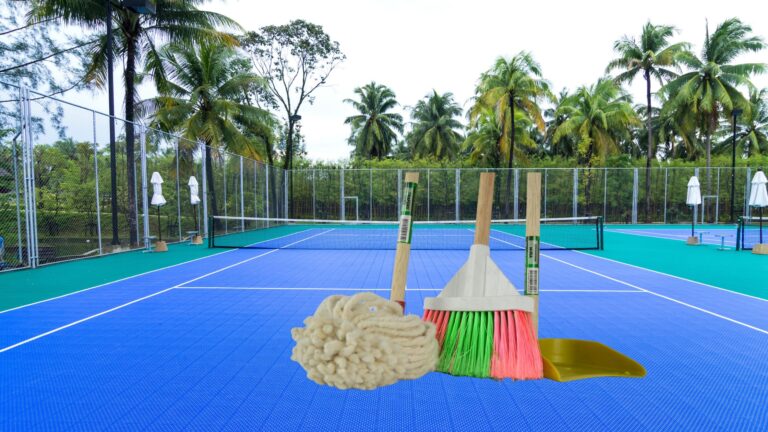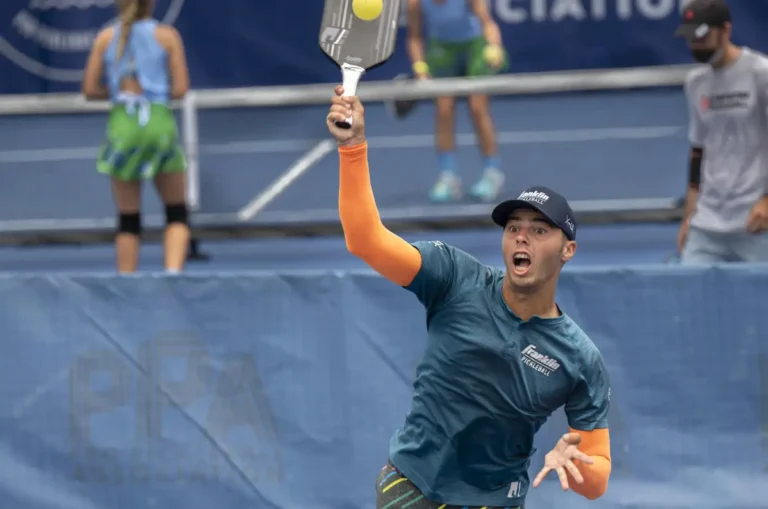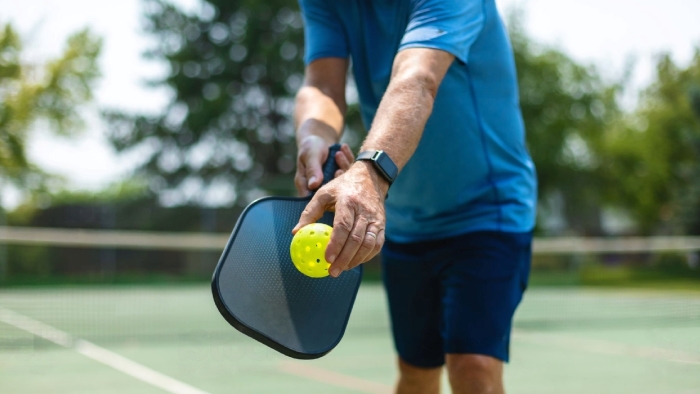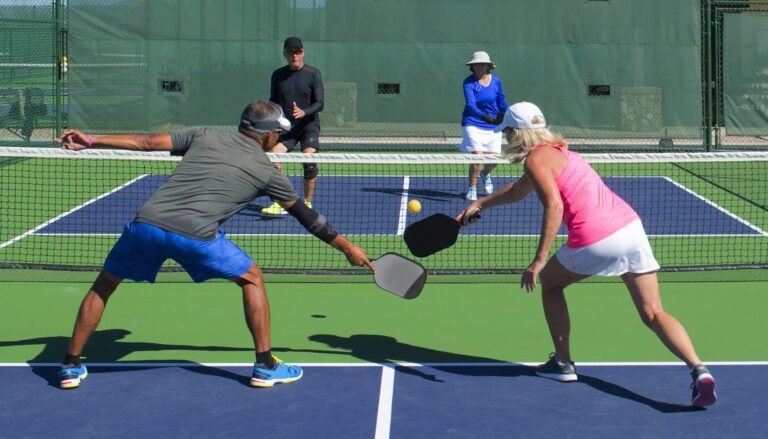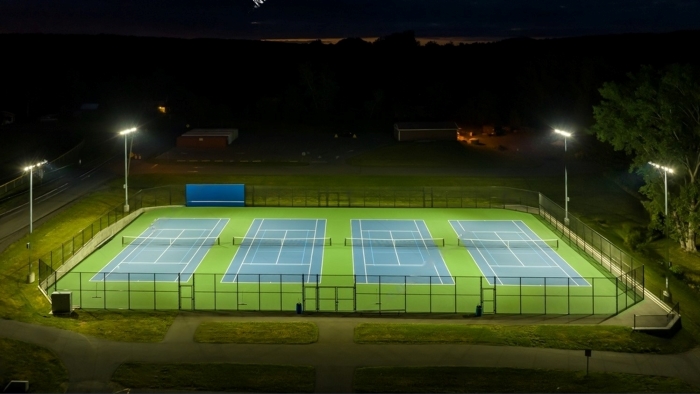Essential Guide to Stacking in Pickleball
Key Takeaways:
- Stacking in pickleball doubles is a strategic positioning technique where both players line up on the same side of the court during the serve.
- It allows teams to maximize their strengths, exploit opponent weaknesses, and keep preferred forehand or backhand shots in play.
- Effective stacking requires coordination, communication, and adaptation based on game dynamics and partner compatibility.
- While legal under pickleball rules, stacking must be implemented properly to avoid disrupting the flow of play or violating positioning regulations.
Essential Guide to Stacking in Pickleball
Pickleball is a game of strategy, finesse, and quick reflexes. In the fast-paced world of doubles play, every advantage counts – and that’s where stacking comes into play. This artful positioning technique has become a staple in competitive pickleball, allowing teams to leverage their strengths and keep their opponents on their toes.
Imagine a well-oiled machine, with both players seamlessly aligning on the same side of the court, ready to strike with their dominant shots. That’s the essence of stacking, a maneuver that can transform your game from ordinary to extraordinary. But mastering this technique requires more than just positioning – it demands a deep understanding of the game, your partner, and your opponents.
Understanding Stacking: The Strategic Realignment
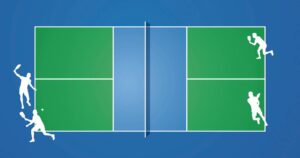
At its core, stacking in pickleball is a legal strategy where both players of a doubles team line up on the same side of the court during the serve. This tactical positioning allows them to switch court sides based on the score, ensuring their stronger shots are always in play.
But stacking isn’t just about taking a side; it’s a carefully choreographed dance between partners, requiring coordination, communication, and a deep understanding of each other’s strengths and weaknesses. It’s a testament to the nuances of pickleball, where strategy and positioning can make all the difference.
Advantages of Stacking: Unleashing Your Team’s Potential
Like a well-executed serve, stacking offers a multitude of benefits that can elevate your game to new heights. Here are some of the key advantages:
- Forehand Fortification: By aligning on the same side, both players can keep their fearsome forehands primed and ready for action. No more awkward backhand scrambles – just pure, unadulterated power. As the saying goes, “Forehands win games, backhands keep you in them.”
- Handedness Harmony: If one player is a lefty and the other a righty, stacking can help compensate for the unique challenges posed by this dynamic duo. It’s like having a secret weapon in your arsenal, a twist that can catch your opponents off guard.
- Exploiting Weaknesses: Every opponent has a chink in their armor, and stacking allows you to strategically position your team to exploit those vulnerabilities. It’s the pickleball equivalent of a well-executed chess gambit, forcing your opponents to play on your terms.
- Court Control: By aligning on the same side, you effectively control a larger portion of the court, making it easier to cover angles and reduce the area your opponents can target. It’s like having an extra line of defense, guarding your territory with precision and finesse.
- Psychological Edge: Stacking can be a mind game, putting your opponents on the defensive and forcing them to adjust their strategies. It’s a subtle psychological advantage that can throw them off their game and give you the upper hand.
How to Implement Stacking: A Step-by-Step Guide
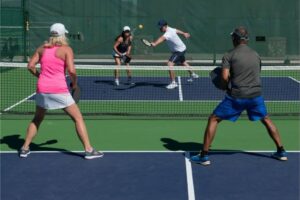
Now that you know the advantages, it’s time to dive into the nitty-gritty of how to implement stacking effectively. Here’s a step-by-step guide:
- Initial Positioning: Before the serve, both players must position themselves on the same side of the court, either the “even” or “odd” side based on the score. This is crucial, as violating the initial positioning rules can result in a fault.For example, if the score is 0-0 (an even score), both players would align on the even side of the court. If the score is 1-0 (an odd score), they would stack on the odd side.
- Serve and Return: During the serve, the non-serving partner typically aligns in a position that doesn’t obstruct the serve, ready to transition after the ball is in play. When returning, the positioning and movement are adapted to maintain the strategic advantages of stacking.For instance, on the serve, the non-serving partner might position themselves slightly behind and to the side of the server, allowing for a clear path. After the serve, both players can shift to their preferred stacking positions, ready to attack the return.
- Coordination and Communication: Stacking is a dance, and like any good dance partners, you’ll need to communicate effectively. Non-verbal cues, such as hand signals or subtle body language, can help ensure smooth transitions without tipping off your opponents.A simple hand signal like tapping your hip could indicate a switch to a defensive stacking formation, while a subtle head nod might signal an aggressive stacking position for the next rally.
- Adaptation: Stacking isn’t a one-size-fits-all strategy. As the game progresses, you may need to adapt your positioning or switch to a different formation based on the dynamics of the match and your opponents’ strategies.For example, if your opponents start targeting the open side of the court with well-placed dinks and drops, you might switch from a full stacking formation to a fluid stacking formation, with one player staying back to cover the open side while the other attacks from the stacked position.
Stacking Techniques: Mastering the Art
While the basic concept of stacking is straightforward, there are various techniques and formations that can take your game to the next level. Here are some essential stacking techniques to add to your repertoire:
Stacking on the Serve
| Technique | Description | When to Use |
|---|---|---|
| Full Stacking | Both players align on the same side of the court for the serve, allowing them to maintain their preferred sides throughout the rally. | When you want to maximize your dominant shot opportunities and put pressure on your opponents from the start. |
| Half Stacking | Only the non-serving partner stacks on the same side, while the server remains in their designated court position. | When you want to maintain court coverage while still gaining a positional advantage on the return. |
Stacking on the Return
| Technique | Description | When to Use |
|---|---|---|
| Aggressive Stacking | Both players stack on the same side, ready to attack the return with their dominant shots. | When you want to take control of the point from the return and put your opponents on the defensive. |
| Defensive Stacking | Players stack on the side opposite the server, prioritizing defensive positioning and court coverage. | When the server has a strong serve or when you want to neutralize the return and reset the point. |
Common Stacking Formations
Stacking isn’t a one-size-fits-all strategy, and different formations can be employed based on the game dynamics and your team’s strengths. Here are some common stacking formations to consider:
- Full Stacking: Both players align on the same side of the court throughout the entire point, maximizing their dominant shot opportunities. This formation is often used when both players have strong forehands or when they want to put maximum pressure on their opponents.
- Half Stacking: One player remains in their designated court position, while the other stacks on the same side, allowing for more flexibility and court coverage. This formation is useful when one player has a stronger shot than the other, or when you want to maintain better defensive positioning.
- Fluid Stacking: Players seamlessly transition between full and half stacking formations, adapting to the ever-changing dynamics of the game. This formation requires excellent communication and coordination between partners, as well as a deep understanding of each other’s strengths and weaknesses.
- Situational Stacking: In this formation, players stack on one side during certain situations, such as when the score is even or when one player is serving, and then switch to a more traditional formation for other situations. This approach adds an element of unpredictability and can keep your opponents guessing.
Tips for Effective Stacking
While stacking can be a game-changer, it’s not without its challenges. Here are some tips to help you master this technique and avoid common pitfalls:
- Communication is Key: Establish clear non-verbal cues with your partner to ensure smooth transitions and avoid collisions or misunderstandings on the court. These cues can be as simple as a hand signal or a subtle body movement, but they must be agreed upon and practiced beforehand.
Here’s a continuation of the expanded article:
- Court Awareness: Maintain situational awareness and adjust your positioning accordingly to avoid disrupting the flow of play or violating positioning rules. Remember, even when stacking, you must adhere to the serving and receiving regulations.
- Practice, Practice, Practice: Like any new skill, stacking takes time and repetition to perfect. Incorporate it into your practice sessions and fine-tune your coordination with your partner. Drill different stacking formations and transition scenarios to build muscle memory and instinctive movements.
- Adaptability: Be prepared to switch formations or abandon stacking altogether if it’s not working effectively or if your opponents have found a way to counter it. Stacking is a tool in your arsenal, not a mandatory strategy for every point.
- Partner Compatibility: Stacking requires a high level of trust, compatibility, and understanding between partners. Take the time to get to know your partner’s strengths, weaknesses, and preferred playing style. The more in sync you are, the more effective your stacking will be.
- Deception: While communication is essential, don’t give away your stacking intentions too easily. Use subtle cues that your opponents are unlikely to pick up on, and consider occasionally using false signals to throw them off your trail.
Challenges and Solutions: Overcoming Obstacles
While stacking offers numerous advantages, it’s not without its challenges. Here are some common obstacles you may encounter and solutions to overcome them:
- Disrupting the Flow of Play: Stacking can sometimes lead to awkward transitions or players getting in each other’s way, disrupting the rhythm of the game. Solution: Clear communication and practice to ensure smooth movements, as well as an awareness of court positioning and partner location.
- Predictability: If your stacking strategy becomes too predictable, opponents may exploit it by targeting the open areas of the court or adjusting their own positioning. Solution: Mix up your formations and positioning to keep them guessing. Incorporate situational stacking or fluid transitions to add an element of unpredictability.
- Partner Compatibility: Stacking requires a high level of coordination and understanding between partners. If you and your partner are not on the same page, it can lead to confusion, miscommunication, and ineffective positioning. Solution: Spend time practicing together, developing non-verbal cues, and building trust and compatibility on the court.
- Rule Violations: Improper positioning or movements during stacking can result in faults or penalties, disrupting the flow of the game. Solution: Thoroughly understand the rules and practice within the guidelines. Pay close attention to the initial positioning requirements for the serve and return.
- Overreliance: While stacking can be a powerful tool, overrelying on it can make your game predictable and limit your ability to adapt to different situations or opponents. Solution: Treat stacking as one of many strategies in your arsenal, and be willing to switch tactics when necessary.
Practical Examples of Stacking: Lessons from the Pros
Sometimes, the best way to understand a technique is to see it in action. Let’s take a look at a couple of real-life examples of stacking from professional pickleball matches:
Example 1: The Lefty-Righty Advantage
In a high-stakes tournament match, a doubles team consisting of a left-handed player and a right-handed player employed a full stacking formation throughout the game. By aligning on the same side, they were able to keep their dominant forehands in play, putting immense pressure on their opponents with blistering cross-court shots.
The lefty-righty combination, combined with the stacking strategy, created a unique challenge for their opponents, who struggled to adjust to the angles and spin generated by the opposing team’s shots.
Lesson Learned: Stacking can be an effective way to compensate for the unique challenges posed by a lefty-righty partnership, allowing both players to maximize their strengths and exploit the element of surprise.
Example 2: Adapting to Opponent Strategies
In a heated battle between two evenly matched teams, one duo started with a full stacking formation. However, their opponents quickly adapted by targeting the open side of the court with well-placed dinks and drops. The stacking team immediately switched to a fluid stacking formation, with one player staying back to cover the open side while the other attacked from the stacked position.
This adjustment allowed them to neutralize their opponents’ tactics while still maintaining the benefits of stacking. By being willing to adapt their formation, they were able to regain control of the court and ultimately prevail in the match.
Lesson Learned: Stacking is not a one-size-fits-all strategy. Be prepared to adapt your formations and positioning based on your opponents’ strategies and the game’s dynamics. Flexibility and the ability to read the court are essential for effective stacking.
Example 3: The Psychological Edge
In a high-pressure tournament final, one team employed a situational stacking strategy, aligning on the same side only when the score was even. This unpredictable approach kept their opponents constantly guessing and adjusting their positioning.
The psychological impact of this strategy was evident, as the opposing team seemed flustered and unable to settle into a consistent rhythm. The stacking team capitalized on this mental edge, using it to gain momentum and ultimately claim the championship title.
Lesson Learned: Stacking can be a mind game, putting your opponents on the defensive and forcing them to adjust their strategies. By keeping them guessing and off-balance, you can gain a psychological edge that can translate into on-court success.
Conclusion: Elevate Your Game with Stacking
Stacking in pickleball is more than just a positioning technique – it’s a strategic mindset that can unlock a whole new level of play for you and your partner. By aligning your strengths, exploiting your opponents’ weaknesses, and maintaining court control, you’ll be well on your way to dominating the doubles game.
But mastering stacking requires more than just understanding the basics. It demands a deep commitment to practice, communication, and adaptability. You must be willing to experiment with different formations, read the court, and adjust your strategies on the fly.
Embrace the challenges and overcome the obstacles, for in the end, stacking can be the difference between a good game and a great one. So grab your paddle, align with your partner, and let the strategic dance begin!

